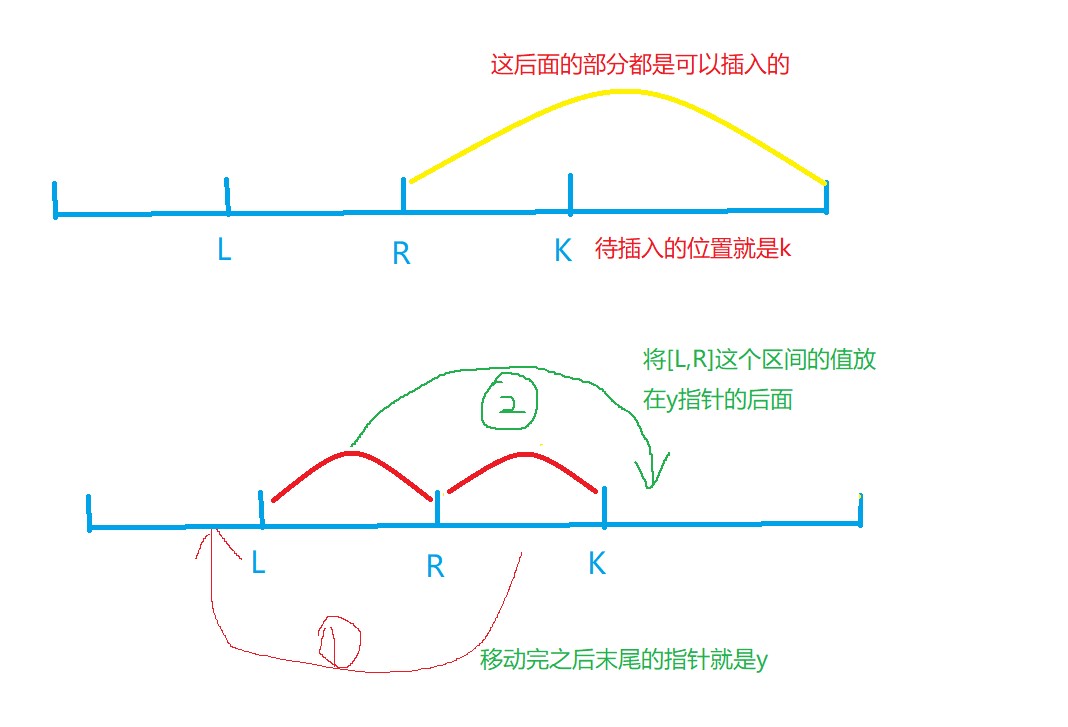IDA*模板题
算法
(IDA*) O($560^{4}$)
先考虑每一步的决策数量:
当抽取长度为 ii 的一段时,有 $ n−i+1 $ 种抽法,对于每种抽法,有 $ n−i $ 种放法。另外,将某一段向前移动,等价于将跳过的那段向后移动,因此每种移动方式被算了两遍,所以每个状态总共的分支数量是:$∑ni=1(n−i)∗(n−i+1)/2 = (15∗14+14∗13+…+2∗1)/2=560$。
考虑在四步以内解决,所以最多有 $560^{4}$ 个状态,会超时。
因此我们用IDA*来解决此题。
本题的估价函数
- 估价函数需要满足:不大于实际步数
- 在最终状态下,每本书后面的书的编号应该比当前书多1。
- 每次移动最多会断开三个相连的位置,再重新加入三个相连的位置,因此最多会将3个错误的连接修正,所以如果当前有 $tot$ 个连接,那么最少需要 $⌈tot/3$⌉ 次操作。
- 因此当前状态 ss 的估价函数可以设计成 $f(s)=⌈tot/3]$。
如果当前层数加上 f(s)f(s) 大于迭代加深的层数上限,则直接从当前分支回溯。
并且由题目可知,答案的深度较浅,所以可以使用迭代加深的方式来求解
区间的移动步骤

IDA*
c++代码
#include<iostream>
#include<cstring>
#include<algorithm>
using namespace std;
const int N = 16;
int q[N]; //存储初始序列
int w[5][N]; //w[i]表示第i次操作时的序列是什么
int n;
//估价函数:
int f(){ //本题的估价函数时计算有多少个不符合要求的后缀点()
int total = 0;
for(int i = 0;i < n - 1;++i){
if(q[i] != q[i + 1] - 1) total ++;
}
return (total + 2) / 3;
}
bool dfs(int u,int max_depth){ //u表示当前的层数,max_depth表示最大的层数
if(f() + u > max_depth) return false;
if(f() == 0) return true; //表示当前已经是顺序了
//枚举抽取的区间长度
for(int len = 1;len <= n;++len){
//枚举当前区间的左端点
for(int l = 0;l + len - 1 < n;++l){
int r = l + len - 1;
//枚举当前区间可以插入的位置:([r + 1 ~ n - 1])
for(int k = r + 1;k < n;++k){
//先记录当前状态,用于等下恢复现场
memcpy(w[u],q,sizeof q);
int y = l;
//移动[R + 1,K]的部分
for(int x = r + 1;x <= k;++x,++y) q[y] = w[u][x];
//移动[L,R]的部分
for(int x = l;x <= r;++x,++y) q[y] = w[u][x];
if(dfs(u + 1,max_depth)) return true;
//恢复现场
memcpy(q,w[u],sizeof q);
}
}
}
return false;
}
int main(){
int t;
cin >> t;
while(t--){
cin >> n;
for(int i = 0;i < n;++i) cin >> q[i];
int depth = 0;
while (depth < 5 && !dfs(0, depth)) depth ++ ;
if(depth >= 5) puts("5 or more");
else cout << depth << endl;
}
return 0;
}
同样的用A*算法也能够完成,但是时间慢了接近200ms左右,
总结了一下应该在何时选择 A∗ 或 IDA∗:
需要最小字典序时,状态表示很大,指数增长较快时,使用IDA∗
若状态容易表示,指数增长较慢时,使用A∗A∗(注意需要最小字典序时不能用A∗,因为他不是按照顺序搜索的)
A*
c++代码
//使用A*
#include<iostream>
#include<cstring>
#include<algorithm>
#include<queue>
#include<unordered_set>
using namespace std;
typedef unsigned long long ULL;
const int N = 16;
int n;
struct state{
int v[N],step,f; //v[]表示当前的序列,step表示当前的步数,f表示当前状态的估计值 + 真实值
//按照估价值 + 真实值进行从大到小排序
bool operator < (const state& x) const{
return f > x.f;
}
}start;
int f(state x){
int res = 0;
for(int i = 1; i < n; i++)
if(x.v[i] - 1 != x.v[i - 1]) res++;
return res % 3 ? res / 3 + 1 : res / 3;
}
ULL get(state x){ //得到state所代表的十进制数
ULL res = 0;
for(int i = 0;i < n;++i){
res += res * 10 + x.v[i];
}
return res;
}
bool check(int v[]){ //判断是否已经到达了目标状态
for(int i = 0;i < n;++i){
if(v[i] != i + 1) return false;
}
return true;
}
unordered_set<ULL> st; //记录状态是否已经被记录过了
int Astart(){
priority_queue<state> que;
start.f = f(start) + 0; //起点的步数为0
que.push(start);
st.insert(get(start));
while(que.size()){
state t = que.top();
que.pop();
if(t.f >= 5) return 5; //直接判断f不用判断step,更快的剪枝
if(check(t.v)) return t.step;
//接下来就是枚举序列变化的过程了
for(int len = 1;len <= n;++len){ //枚举长度
for(int l = 0;l + len - 1 < n;++l){ //枚举当前区间的左端点
int r = l + len - 1;
for(int k = r + 1;k < n;++k){ //枚举可以插入的位置
state cur; //用cur来记录更新的状态
for(int i = 0;i < n;++i) cur.v[i] = t.v[i];
int y = l;
for(int x = r + 1;x <= k;++x,++y){
cur.v[y] = t.v[x];
}
for(int x = l;x <= r;++x,++y){
cur.v[y] = t.v[x];
}
if(st.count(get(cur)) > 0) continue;
st.insert(get(cur));
cur.step = t.step + 1;
cur.f = f(cur) + cur.step;
que.push(cur);
}
}
}
}
}
int main(){
int t;
cin >> t;
while(t--){
cin >> n;
st.clear(); //每次记得把st清空
for(int i = 0;i < n;++i) cin >> start.v[i];
int t = Astart();
if(t >= 5) cout << "5 or more" << endl;
else cout << t << endl;
}
return 0;
}

